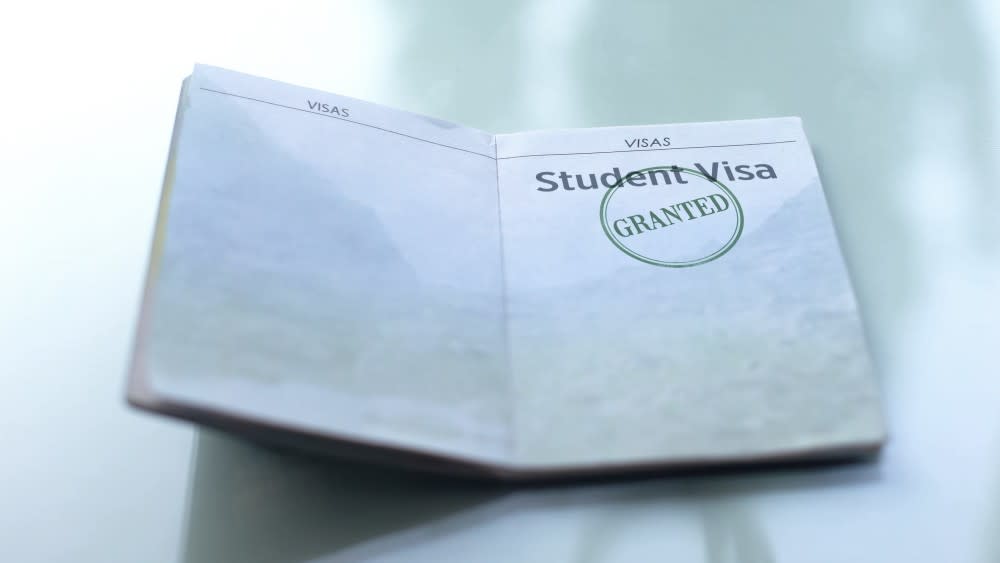If you plan to study in the US, you will need to understand US student visa requirements before you apply for a student visa. The US offers three main types of student visas: F-1, J-1, and M-1. While these visas share some similarities, they apply to different types of programs and have unique requirements and documentation.
To help you understand which visa would suit you best, this guide will help you learn more about US student visa requirements, US student visa eligibility, and US student visa required documents.
Student Visas
Your F-1, M-1, and J-1 student visa processes begin after your application is accepted by a US institution accredited by the Student and Exchange Visitor Program (SEVP). Once your application is accepted, the university, college, or institution will provide you with a specific form: the I-20 form for F-1 and M-1 type visas, and the DS-2019 form for J-1 students. These forms list important information about your program including start and end dates, cost breakdowns, and options for financial support.
These two forms also help prove that you are traveling to the US to study and plan to return to your home country. To help you explore your options, Shorelight provides support with research and resources for international students.
F-1 Visa
As the most common student visa among international students applying to study in the US, the F-1 visa permits you to study at US institutions with funding from friends and family, or by financing your education yourself.
As an F-1 student, you can also work part time on campus for a maximum of 20 hours per week when your academic term is in session. (You are also able to work full time during academic breaks.) F-1 students can only work off campus with permission from their US university or college.
You may be eligible to apply for Optional Practical Training (OPT), which will allow you to work up to 12 months in a field related to the program you studied. You can apply for OPT while pursuing your program (pre-completion OPT) or after you complete your program and graduate (post-completion OPT). If you are a STEM graduate, you can request two additional years of work in a related field. If you do not have a F-1 extension, you will have to leave the US within 60 days after your graduation.
J-1 Visa
The J-1 student visa is for international students who want to participate in study- and work-related exchange programs at US colleges or universities. Your institute and its programs must be approved by the Department of State Bureau of Educational and Cultural Affairs, and your enrollment must be funded by an educational or nonprofit sponsor.
J-1 students have the same work restrictions as F-1 students, but are not permitted to work off campus. However, exceptions may be made for off-campus work under certain circumstances. Instead of OPT, J-1 students can pursue Academic Training (AT) in a field related to their program after graduation for up to 18 months. STEM undergraduate students and pre-doctoral students may be eligible for an extension, allowing for a maximum total of 36 months of AT.
Students with J-1 status have a unique requirement called the Home Residency Requirement: After graduation, J-1 students must return to their home countries and live there for at least two years before returning to the US (if they have no other extensions). Students are required to return to their home countries within 30 days after they complete their programs.
M-1 Visa
Students who wish to travel to the US to enroll in vocational studies or for non-academic purposes can apply for a M-1 visa. If you are enrolling in vocational studies, the institute must be SEVP-certified and the funding for your expenses can come from friends, family, or yourself.
M-1 students have similar work restrictions as F-1 and J-1 students, but can only work for a maximum of six months and require a work permit or Employment Authorization Document (EAD).
Note: If you are a M-1 student, you cannot change your program or transfer institutions six months after starting your program. Additionally, on a M-1 visa, you would only be permitted to work full time in practical training after completing your program first. You can learn more about your opportunities for employment on Uscis.gov.
Student Visa Age Requirements
There are no age restrictions or requirements for submitting your application for F-1 and M-1 student visas.
As the J-1 student visa has many different types of categories, the age range will depend on the category you select (for example, applicants for the J-1 Intern Program must be at least 18 years old). For the J-1 College and University Student Program, there is currently no age requirement.
Age will only determine the requirement for a visa interview, and will mainly impact any dependents who may accompany you. Children ages 13 and younger do not require interviews and individuals aged 14 to 79 will require visa interviews. Individuals older than 80 generally will not require a visa interview.
Documentation Required for Student Visas
As part of your US student visa requirements, you will need to prepare the following documents for your visa interview:
For F-1 students:
Certificate of Eligibility for Nonimmigrant (F-1) Student Status-For Academic and Language Students, Form I-20
For J-1 students:
Certificate of Eligibility for Exchange Visitor (J-1) Status, Form DS-2019
For M-1 students:
Certificate of Eligibility for Nonimmigrant (M-1) Student Status for Vocational Students, Form I-20
For all student visa applicants:
A valid passport
A copy of the photo you will use for your visa
The DS-160 and I-901 Student and Exchange Visitor Information System (SEVIS) payment confirmation pages
If you need any help with understanding the documents and how you can obtain them, please visit Shorelight’s visa assistance services.
Additional Documentation
A consular officer will conduct your visa interview and may request additional documents and qualifications such as your:
School transcript and official test scores as stated on your university application
Academic transcripts and certificates (if applicable)
Bank statements (or other proof of financing)
Evidence of your intent to depart the United States after completing your program
You can contact your nearest US embassy or consulate to find more information on US embassy student visa requirements.
Once you have prepared these documents, you are ready to apply for your US student visa.
Here is what you need to know about each step of the student visa application process.
Get Accepted to a Certified US University
Once you are accepted by a SEVP-accredited institution, you can apply for the student visa that best suits your needs. A certified US university shows that the US government acknowledges that the institute where you hope to study is accredited and has the right resources to grant you an academic degree.
If you are uncertain about how to begin applying to US universities or colleges, Shorelight provides application assistance for international students like you.
Complete Your I-20 or DS-2019 Form
Once you are accepted, your university will provide your I-20 form so you can apply for a F-1 or M-1 visa, or a DS-2019 form for a J-1 visa. To issue your I-20 or DS-2019, SEVIS records the following information:
SEVIS ID number
Intended program of study
Program start and end dates
Funding sources
Cost of attendance at your school
Other personal information
When you receive your I-20 or DS-2019, make sure to check if the information is accurate. Fixing an error on these forms can take a long time and if there is a mistake, you may not be granted access to enter the US. Once you have verified the information, sign the bottom of the first page.
Keep your form safe! It will be required in the US for academic records, employment, and more.
Pay the SEVIS Fee
The I-901 SEVIS fee of $350 is a processing and maintenance charge for your application. You can pay the fee on the SEVIS payment portal and it will require information from your I-20 or DS-2019 to complete the process. Do not forget to keep your payment receipt — it is needed for your visa interview!
Complete Your DS-160 Visa Application
The next step is to fill out your DS-160 application. Once you submit the DS-160, you will receive a printed confirmation with a barcode that will also be required for your visa interview. To view the DS-160 application, you can visit the application portal.
To fill out this application, you will need to have your I-20 or DS-2019, passport, travel itinerary, and a photo for your visa. You have to pay an application charge of $185.
Student Visa Interview
Your next step will be scheduling your visa interview at the nearest US embassy or consulate. Schedule your appointment as early as you can, as delays in wait times can take weeks or months, depending on where you are applying. The scheduling portal can help you find the ideal time to schedule your visa interview. Payment from your DS-160 will cover the cost of your interview.
Each type of student visa has its unique focus and your interview will be different based on your particular visa. For example, during a F-1 student visa interview, the consular officer may ask you about your plans for future work after your studies are complete. A common focus for each interview is proving you have enough funding to cover your stay in the US and your plans to return home after graduation.
It is mandatory for you to attend your visa interview, with the exception of children ages 13 and younger or if you meet certain visa renewal requirements. Remember to bring your US student visa required documents with you, as the consular officer will check them.
Successfully completing your student visa interview will grant you your F-1, J-1, or M-1 visa, and you will then be eligible to enter and study in the US! For more details about the application process, you can visit Travel.state.gov.
Now that you understand the different types of US student visas and US student visa requirements, you can start researching each type of student visa to find out which visa best suits your goals. Remember to start early, as this will give you time to consider your options and discover opportunities to begin your new life in the US!
Are you ready to join more than one million international students in the US? Apply to a Shorelight university today >

